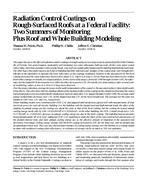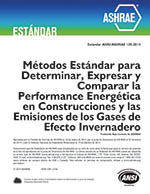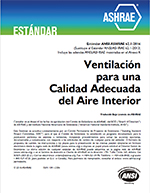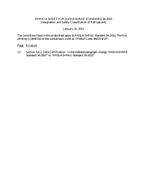Description
This paper discusses the effect of radiation control coatings on rough-surfaced, low-slope roofs at a federal facility in the Panhandle of Florida. Two gravel-topped, moderately well-insulated, low solar reflectance built-up roofs (BURs) were spray coated with a white, latex-based product with ceramic beads. One roof was significantly shaded and its building had high internal loads. The other had a thermally massive deck but its building had little internal load. Samples of the coated roofs were brought periodically to the laboratory to measure the solar reflectance as the coatings weathered. Relative to the uncoated BUR, the fresh coating increased the solar reflectance from 0.09 to about 0.53, which is at least 0.2 lower than has been observed for similar fresh white coatings on smooth, low-sloped surfaces. In the course of the project, from July 1996 through October 1997, the reflectance for the shaded BUR decreased to 0.42 while the other decreased to 0.50. On smooth, low-slope surfaces after several years of weathering, values as low as 0.50 to 0.55 have been observed. Over the project duration, average decreases in the sunlit temperatures of the coated vs. the uncoated surfaces show slight weathering effects. They also show that the shading enhanced the measured effect of the coating on the shaded roof because the coated instrumented area on it was preferentially shaded near noon on sunny days. For August through October 1996, the average sunlit surface temperature decreases were 13% on the shaded roof and 12% on the heavyweight roof. The averages for the same two months in 1997 were 12% and 11%, respectively. Whole building models were constructed for DOE-2.1E and adjusted until predictions agreed well with measurements of total electrical power for each all-electric building. For the building with the shaded roof and high internal loads, the effect of the shading on annual energy use for cooling was about the same as that of the fresh coating, but the coating decreased annual cooling energy needs only by 0.8% (0.054 kWh/ft2 or 0.58 kWh/m2). In the other building, the DOE-2 model predicted a 7.4% (0.27 kWh/ft2 or 2.9 kWh/m2 ) decrease in annual cooling energy use due to the fresh coating. This building had an unconditioned plenum under all of its roof. Additional DOE-2.1E modeling to study the effect of the roof construction and presence of the plenum showed more and more annual cooling energy use as the effective amount of insulation in the uncoated roof decreased. Percentage cooling energy savings with the fresh coating increased to 43% for the final case with no plenum and an uninsulated metal roof. This case also showed that estimates of cooling energy savings over the lifetime of a coating should be done with weathered coating solar reflectances, or estimates of savings can be as much as 50% too optimistic.
AUTHOR: Thomas W. Petrie, Ph.D. Phillip W. Childs, Jeffrey E. Christian
CITATION: Thermal Performance of the Exterior Envelopes of Buildings VII
KEYWORDS: December, Florida, 1998
YEAR: 1998
Citation: Thermal Performance of the Exterior Envelopes of Buildings VII
Product Details
- Published:
- 1998
- File Size:
- 1 file , 910 KB
- Product Code(s):
- D-8086




